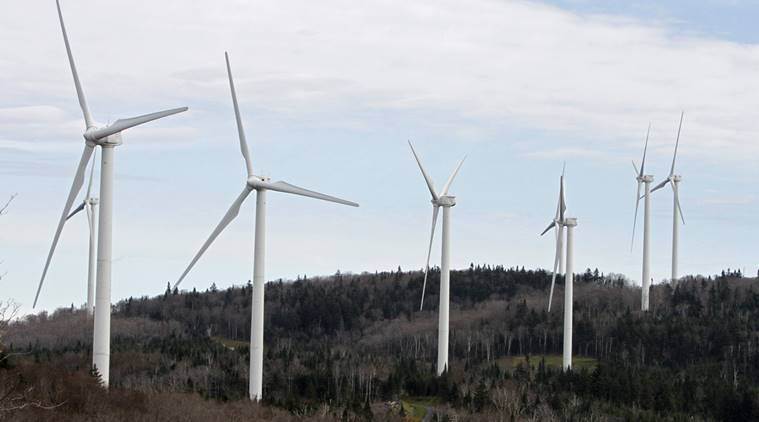 Finance Minister Nirmala Sitharaman’s directions in her Budget speech to utilities to close old thermal plants with high carbon emission levels might encourage the growth of renewables. (File)
Finance Minister Nirmala Sitharaman’s directions in her Budget speech to utilities to close old thermal plants with high carbon emission levels might encourage the growth of renewables. (File)
Renewable energy projects, which have cornered the bulk of private funding in the power sector over the last six years, could be facing a fresh wave of non-performing assets (NPAs). There is renewed nervousness among banks that lending to renewable power utilities over the last five years could turn bad.
In a deposition before a Parliamentary panel, a senior government official flagged that “outstanding payments” due to renewable energy developers “is a very big issue and an issue of concern” and that “if the situation will not get improved, many solar and wind projects may turn into NPAs”.
The power sector accounts for almost half the credit to the infrastructure sector, with the telecom sector coming in second. In the power sector, the renewable energy sector witnessed significant FDI inflows of $3.22 billion over the last four years. This came alongside domestic investment leveraged mostly by bank funding.
Renewing concerns
The concern over renewable energy comes amid uncertainty posed by the SC’s decision to uphold the government’s definition of adjusted gross revenue, which impacts telecom majors. There are fears over loans in aviation, too, due to groundings, thin margins, and fuel price volatility.
So far, in the renewable energy sector, while there have been NPAs in the hydro and biomass sectors, there has not been a single instance of an investment in the wind sector and solar sector turning bad.
The concerns stem from mounting payment dues of renewable energy generators, primarily as distribution companies (discoms) of states such as AP, TN and Telangana have been falling back on payments for electricity contracted. The dues were pegged at Rs 9,403.58 crore upto end-November 2019, with Andhra Pradesh, Tamil Nadu, Telangana, Karnataka and Rajasthan together contributing over 85 per cent of the total, according to data compiled by the Central Electricity Authority.
Opinion | Power replay
Delays have started to stretch beyond 12 months in some cases, effectively impeding the working capital flows for these companies and hindering their debt servicing capability — a warning sign for lenders. In all, over 15 discoms have fallen back on payment obligations against electricity supplied by solar and wind energy developers — the only spark in an otherwise sluggish sector.
“There are outstandings by discoms, not only to the renewable energy sector, but also to the conventional energy sector. That is something which we have taken up with the states. We have raised this thing that they pay, and they pay quickly,” R K Singh, MoS (Independent Charge) for Power and New and Renewable Energy, told The Indian Express.
“I have asked the ministry to set a timeline of about 6 months,” said the minister, adding, “We will make sure that the discoms pay. We are pressurising them.”
Finance Minister Nirmala Sitharaman’s directions in her Budget speech to utilities to close old thermal plants with high carbon emission levels might encourage the growth of renewables. But the government has also signalled that it would allow the possibility of imposing tariffs up to 20 per cent on solar cells.
India has limited domestic capacity to produce these products, according to Wind Independent Power Producers Association president Sunil Jain. “Today, 85 per cent is imported. Even the domestic capacity is basically only in assembling the module. Even the cells are imported from China,” said Jain, who is also CEO of Hero Future Energies.
Upto end-August 2019, installed renewable power capacity stood at around 80.63 gigawatts. The red flags come in the wake of two state-owned discoms of Andhra Pradesh moving to reopen contracts signed with wind generators earlier this year, a step that threatened to impact at least 40 of India’s biggest RE developers. This had triggered concerns that other states could initiate similar reopening of wind and solar project PPAs (power purchase agreements) on the same grounds — that tariffs discovered in subsequent years have been cheaper.
According to analysts, firms with a higher proportion of assets exposed to states like Andhra Pradesh are under greater stress.
During that period, over 20 firms, including ACME Solar, Renew Power and Tata Power Renewable, approached the Andhra Pradesh High Court against the move. According to the court’s judgment, they had argued that they had invested “huge sums of money and have borrowed equally large sums” to establish their plants in the state. They had calculated a return on investment based on factors like tariff and had argued that, if their capacity was curtailed, it “would drive them into debt”.
“The full payouts (in Andhra) are still not coming — that money is stuck at present. So there are some renewable players who are certainly facing cash flow challenges as far as this is concerned,” said Manish Gupta, Senior Director, CRISIL Ratings.
Industry executives are divided in their views over the gravity of the situation in the sector following the Andhra Pradesh issue. While Vineet Mittal, president of Solar Power Developers Association, said the enforcement of a letter of credit system has helped improve payments, Wind Independent Power Producers Association chief Jain said the situation is “risky”. The exposure of banks in renewable projects in Andhra Pradesh alone currently stands at around Rs 35,000 crore, according to him.